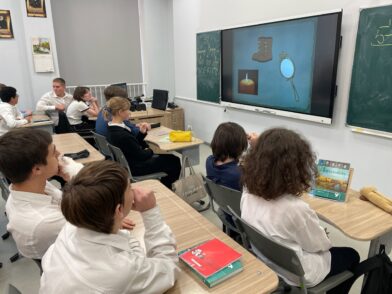U. S. Information Service American English & Culture
Hello again, dear friends!
This week we will continue our survey of American holidays. In many of our previous pages, Richard Daigle talked about some national and religious holidays celebrated in the United States. Today, I would like to focus on some local and ethnic festivities.
Other American Celebrations
Although the United States is young compared to other countries, its culture and traditions are rich because of the contributions made by the many groups of people who have come to its shores over the past two centuries. Hundreds of regional holidays have originated from the geography, climate and history of the different parts of the country. Each state holds its own annual fair with local themes and music; and some celebrate the day on which they joined the Union and became a state.
Throughout the northeastern states, the main attractions are festivals that welcome in the autumn as the leaves on the trees begin to turn red, orange and yellow. Warner, New Hampshire holds a Fall Foliage Festival which offers a wood-chopping contest and an auction. Towns in Vermont welcome tourists who drive along the scenic mountain roads to view the colors of the leaves. When the weather becomes chillier, and snow begins to fall, skiing tournaments attract professional and amateur skiers in hilly towns such as Stratton, Vermont.
The leaves turn color a little later in October in Bedford, Pennsylvania where the townspeople celebrate the fall foliage by demonstrating ways of cooking that have been handed down to them by their ancestors. In the nearby Pennsylvania Dutch region, people are proud of their European ancestry, and celebrate it through seasonal festivals. In Kutztown and other rural Pennsylvania towns, spring festivals are common, with costumed pageants and parades.
Farther south, battles are re-enacted in historical celebrations such as the Revolutionary War Days in Waldorf, Maryland. Confederate Civil War general Robert E. Lee`s birthday is commemorated in January in various southern states, while other southern states observe Confederate Memorial Day in April or June. People in many southern states welcome spring with dancing. Celebrants of the Dixie Holiday in Shreveport, Louisiana carry on the early American tradition of square dancing; and in the National Square Dance Festival in Slade, Kentucky, dancers, singers and musicians enter competition in hopes of winning awards. In Biloxi, Mississippi, celebrants even dance in the streets during the festival marking the blessing of the shrimp fleet in June. A mass is held as well, in thanks for the fish harvested from the Gulf of Mexico.
Folk fairs in the American Midwest offer foods of ethnic diversity, because people of so many different nationalities have settled there. In May, the townspeople of Orange City, Iowa and Holland, Michigan celebrate their Dutch ancestry through a yearly Tulip Festival.
African Americans have begun to observe Kwanzaa, a holiday based on the African celebration of the first harvest of the year, December 26 through January 1. Developed in 1966, by a black studies professor at California State University, Maulana Karenga, Kwanzaa celebrates the unity and development of the African community. Founded upon the “Nguzo Saba”, or the seven principles of unity, self determination, collective work and responsibility, cooperative economics, purpose, creativity and faith, Kwanzaa encourages African Americans to think about their African roots in addition to their present-day life in America. African Americans will exchange gifts as rewards for their achievements; and they will light the “Mishumaa Saba” or seven candles to remind them of the seven principles which unite them.
Winters are long in many midwest states, so winter festivals have become social events. In St. Paul, Minnesota, the Winter Carnival offers exhibitions in skating, skiing, ice fishing and even snowmobile races. In Houghton Lake, Michigan, a winter festival called Tip-Up-Town USA offers a contest for the best sculpture carved in ice!
Farther west, in the summer, religious ceremonies mark the Mormon Miracle Pageant in Manti, Utah. In St. Maries, Idaho during Paul Bunyan Days in August, townspeople commemorate this legendary American lumberjack by holding tree-cutting contests. Aspen, Colorado holds the annual summer Music Festival where musicians of classical and contemporary music can perform or hold classes. The coastal town of Santa Barbara, California pays tribute to the early settlers who came from Spain, by performing historical plays during the Old Spanish Days in August. The northwestern state of Oregon boasts a rose festival in Portland, where bands play music in a parade of flowers and floats. In nearby Washington, spring is welcomed in with a Daffodil Festival offering a parade of floats made from these brilliant yellow flowers.
Spring in the southwest finds the townspeople of Okeene, Oklahoma catching snakes in the Rattlesnake Roundup. In Houston, Texans come to the Astrodome to see cowboys ride horses and rope cattle during the Livestock Show and Rodeo. Visitors watch the Hopi Indians carry on their strong tradition of rain dancing, a combination of dancing and prayer to invoke rain in a hot dry August. Many other holidays of the southwest offer a western theme. Tombstone, Arizona celebrates Helldorado Days in the autumn, while in Tucson, cowboys and Indians show their skills in La Festival de los Vaqueros, or the Cowboy Festival. Lincoln, New Mexico holds Pony Express races in honor of the first U.S. mail system and a fiddlers` convention as part of Lincoln County Days.
Alaska and Hawaii, the two youngest states, have climates and histories different from each other and the rest of the country. Nome, Alaska has daylight almost twenty-four hours a day in June, so raft races and midnight baseball games are the mein events in the Midnight Sun Festival. In Kodiak, a King Crab Festival during crab-harvesting season in May, and the Iceworm Festival in Cordova offers airboat races.
Hawaii is warm the year round, and flower festivals were held there even before it became a state. The Narcissus Festival in April has Chinese origins. “Lei Day is May Day” say the celebrants on May first. However, the lei, a large colorful garland of orchids worn around the neck, is a sign of friendship and welcome for visitors to the islands all year. The biggest celebration of the year is the legal holiday Kamehameha Day on June 11. The festivities begin outside Iolani, the only palace in America, when members of Hawaiian societies and organizations sing and chant ancient praises for King Kamehameha the First, who established a unified kingdom of islands by 1810. Honolulu begins to fill with enormous floats, on which costumed people stand among scenes from the history of Hawaii. Someone is chosen every year to sit on the main float and represent King Kamehameha the First, who was the first of five monarchs to rule Hawaii over a hundred years.
These are only a small representation of the hundreds of holidays and celebrations observed throughout the United States. Each state has its own individual history and people, and the right to celebrate its own traditions. But one thing is certain – all Americans welcome you to celebrate with them!
Glossary
originate(d): v. to come from
climate: n. the weather conditions of a geographic region
foliage: n. leaves on trees and plants
auction: n. a sale in which people compete for objects by offering their own prices
scenic: adj. having views and landscapes pleasing to the eye
fiery: adj. like the color of fire
chilly (ier): rather cold
hand(ed) down: pass from one generation to another
pageant(s): n. a theatrical performance during a festival
re-enact(ed): v. perform again
mass: n. the worship service of the Catholic Church
harvest(ed): v. to gather a crop
ethnic: adj. having to do with different national groups and their customs
nationality(ies): n. citizenship; country of origin
snowmobile: n. motorized snow vehicle
lumberjack: n. woodcutter
invoke: v. to ask for with desire
Pony Express: n. the early mail delivery system in the American West where mail was moved by relays of riders on horseback.
fiddler(s): n. musician who plays the fiddle, a type of violin
raft: n. flat boat, usually home-made
garland: n. a large necklace made from flowers
chant: v. to sing with many of the same tones; to recite words with the same unchanging tone
kingdom: n. a form of government with a king or queen as the head
LETTERS
We invite you to send us your questions about American English and American culture. We will attempt to answer all letters personally as well as on this page when space permits. And if there are particular subjects you want us to discuss, please let us know. Our address is:
English Language Office/USIS
Embassy of the United States
Novinskiy Blvd., 19/23
121099, Moscow
Tel: (095) 956-4493
Fax: (095) 255-9766







 Выбор читателей
Выбор читателей






Комментарии